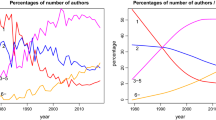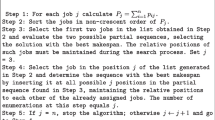Abstract
This study presents a mixed model that combines different indicators to describe and predict key structural and dynamic features of emerging research areas. Three indicators are combined: sudden increases in the frequency of specific words; the number and speed by which new authors are attracted to an emerging research area, and changes in the interdisciplinarity of cited references. The mixed model is applied to four emerging research areas: RNAi, Nano, h-Index, and Impact Factor research using papers published in the Proceedings of the National Academy of Sciences of the United States of America (1982–2009) and in Scientometrics (1978–2009). Results are compared in terms of strengths and temporal dynamics. Results show that the indicators are indicative of emerging areas and they exhibit interesting temporal correlations: new authors enter the area first, then the interdisciplinarity of paper references increases, then word bursts occur. All workflows are reported in a manner that supports replication and extension by others.









Similar content being viewed by others
References
Adamson, I. (1992). Access and retrieval of information as coordinates of scientific development and achievement in Nigeria. Scientometrics, 23(1), 191–199.
Bettencourt, L., Kaiser, D., Kaur, J., Castillo-Chavez, C., & Wojick, D. (2008). Population modeling of the emergence and development of scientific fields. Scientometrics, 75(3), 495–518.
Boyack, K. W. (2004). Mapping knowledge domains: Characterizing PNAS. Proceedings of the National Academy of Sciences of the United States of America, 101(Suppl 1), 5192–5199.
Braun, T., Glänzel, W., & Schubert, A. (1987). One more version of the facts and figures on publication output and relative citation impact of 107 countries, 1978–1980. Scientometrics, 11(1), 9–15.
Braun, T., Glänzel, W., & Schubert, A. (1989a). Assessing assessments of British science: Some facts and figures to accept or decline. Scientometrics, 15(3), 165–170.
Braun, T., Glänzel, W., & Schubert, A. (1989b). The newest version of the facts and figures on publication output and relative citation impact: A collection of relational charts, 1981–1985. Scientometrics, 15(1–2), 13–20.
Braun, T., Schubert, A., & Zsindely, S. (1997). Nanoscience and nanotechnology on the balance. Scientometrics, 38(2), 321–325.
Chen, C. (2006). Citespace II: Detecting and visualizing emerging trends and transient patterns in scientific literature. Journal of the American Society for Information Science and Technology, 57(3), 359–377.
Chen, C., Chen, Y., Horowitz, M., Hou, H., Liu, Z., & Pellegrino, D. (2009). Towards an explanatory and computational theory of scientific discovery. Journal of Informetrics, 3(3), 191–209.
Chu, H. (1992). Communication between Chinese and non-Chinese scientists in the discovery of high-TC superconductors: II. The informal perspective. Scientometrics, 25(2), 253–277.
Garfield, E., & Small, H. (1989). Identifying the change frontiers of science. In M. Kranzberg, Y. Elkana, & Z. Tadmor (Eds.), Conference proceedings of innovation: At the crossroads between science and technology (pp. 51–65). Haifa, Israel: The S. Neaman Press.
Goffman, W. (1966). Mathematical approach to the spread of scientific ideas: The history of mast cell research. Nature, 212(5061), 452–499.
Goffman, W. (1971). A mathematical method for analyzing the growth of a scientific discipline. Journal of Association for Computing Machinery, 18(2), 173–185.
Goffman, W., & Harmon, G. (1971). Mathematical approach to the prediction of scientific discovery. Nature, 229(5280), 103–104.
Goffman, W., & Newill, V. A. (1964). Generalization of epidemic theory: An application to the transmission of ideas. Nature, 204(4955), 225–228.
Hirsch, J. E. (2005). An index to quantify an individual’s scientific research output. Proceedings of the National Academy of Sciences of the USA, 102(46), 16569–16572.
Kajikawa, Y., Yoshikawaa, J., Takedaa, Y., & Matsushima, K. (2008). Tracking emerging technologies in energy research: Toward a roadmap for sustainable energy. Technological Forecasting and Social Change, 75(6), 771–782.
Kim, M.-J. (2001). A bibliometric analysis of physics publications in Korea, 1994–1998. Scientometrics, 50(3), 503–521.
Klavans, R., & Boyack, K. W. (2009). Toward a consensus map of science. Journal of the American Society for Information Science and Technology, 60(3), 455–476.
Kleinberg, J. (2003). Bursty and hierarchical structure in streams. Data Mining and Knowledge Discovery, 7(4), 373–397.
Kuhn, T. S. (1970). The structure of scientific revolutions. Chicago: University of Chicago Press.
Lee, W. H. (2008). How to identify emerging research fields using scientometrics: An example in the field of information security. Scientometrics, 76(3), 1588–2861.
Lewison, G. (1991). The scientific output of the EC’s less favoured regions. Scientometrics, 21(3), 383–402.
Leydesdorff, L., & Schank, T. (2008). Dynamic animations of journal maps: Indicators of structural changes and interdisciplinary developments. Journal of the American Society for Information Science and Technology, 59(11), 1810–1818.
Lucio-Arias, D., & Leydesdorff, L. (2007). Knowledge emergence in scientific communication: From “Fullerenes” to “nanotubes”. Scientometrics, 70(3), 603–632.
Mane, K., & Börner, K. (2004). Mapping topics and topic bursts in PNAS. Proceedings of the National Academy of Sciences of the United States of America (PNAS), 101(Suppl 1), 5287–5290.
Menard, H. W. (1971). Science: Growth and change. Cambridge, MA: Harvard Univ Press.
Merton, R. K. (1968). The matthew effect in science: The reward and communication systems of science are considered. Science, 159(3810), 56–63.
Porter, A. L., & Rafols, I. (2009). Is science becoming more interdisciplinary? Measuring and mapping six research fields over time. Scientometrics, 81(3), 719–745.
Price, D. J. D. S. (1970). Citation measures of hard science, softscience, technology, and nonscience. In C. E. A. P. Nelson, D. (Ed.), Communication among scientists and engineers (pp. 3–12): Heath Lexington Books, Massachusetts.
Rao, C. R. (1982). Diversity: Its measurement, decomposition, apportionment and analysis. Sankhy: The Indian Journal of Statistics, Series A, 44(1), 1–22.
Scharnhorst, A., & Garfield, E. (2010 in press). Tracing scientific influence. Dynamic of Socio-Economic System, 2(1).
Sci2 Team. (2009a). Science of Science (Sci2) Tool: Indiana University and SciTech Strategies, Inc. http://sci2.cns.iu.edu. Accessed 8 June 2010.
Sci2 Team. (2009b). Stop word list. http://nwb.slis.indiana.edu/svn/nwb/trunk/plugins/preprocessing/edu.iu.nwb.preprocessing.text.normalization/src/edu/iu/nwb/preprocessing/text/normalization/stopwords.txt. Accessed 11 June 2010.
Serenko, A., Bontis, N., Booker, L., Sadeddin, K., & Hardie, T. (2010). A scientometric analysis of knowledge management and intellectual capital academic literature (1994–2008). Journal of Knowledge Management, 14(1), 3–23.
Small, H. (2006). Tracking and predicting growth areas in science. Scientometrics, 63(3), 595–610.
Stirling, A. (2007). A general framework for analysing diversity in science, technology and society. Journal of the Royal Society Interface, 4(15), 707–719.
Takeda, Y., & Kajikawa, Y. (2009). Optics: A bibliometric approach to detect emerging research domains and intellectual bases. Scientometrics, 78(3), 543–558.
Thomson Reuters (2010). Web of science. http://scientific.thomsonreuters.com/products/wos/. Accessed 8 June 2010.
Tsipouri, L. (1991). Effects of EC R&D policy on Greece: Some thoughts in view of the stride programme. Scientometrics, 21(3), 403–416.
Van Raan, A. F. J. (2000). On growth, ageing, and fractal differentiation of science. Scientometrics, 47(2), 1588–2861.
Watts, R. J., & Porter, A. L. (2003). R&D cluster quality measures and technology maturity. Technological Forecasting and Social Change, 70(8), 735–758.
Weingart, S., Guo, H., Börner, K., Boyack, K. W., Linnemeier, M. W., & Duhon, R. J., et al. (2010). Science of Science (Sci2) Tool User Manual. http://sci2.wiki.cns.iu.edu. Accessed 28 Jan 2011.
Zitt, M., & Bassecoulard, E. (2008). Challenges for scientometric indicators: Data de-mining, knowledge flows measurements and diversity issues. Ethics in Science and Environmental Politics, 8, 49–60.
Acknowledgments
We would like to thank Joseph Biberstine and Russell J. Duhon for developing custom queries and code and appreciate the expert comments from the three anonymous reviewers. This work is funded by the James S. McDonnell Foundation and the National Institutes of Health under awards R21DA024259 and U24RR029822.
Author information
Authors and Affiliations
Corresponding author
Rights and permissions
About this article
Cite this article
Guo, H., Weingart, S. & Börner, K. Mixed-indicators model for identifying emerging research areas. Scientometrics 89, 421–435 (2011). https://doi.org/10.1007/s11192-011-0433-7
Received:
Published:
Issue Date:
DOI: https://doi.org/10.1007/s11192-011-0433-7




